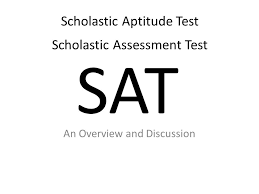Scholastic Assessment Test – SAT Examination
What is SAT Examination
The SAT (Scholastic Assessment Test) is a standardized test widely used for college admissions in the United States. It is designed to assess a student’s readiness for college-level academics and is administered by the College Board, a non-profit organization.

The SAT measures a student’s knowledge and skills in three main areas: Reading, Writing and Language, and Math. The test consists of multiple-choice Questions, with an optional essay section. The Reading section assesses reading comprehension skills, The Writing and Language section evaluates grammar and writing skills, and the Math section tests mathematical reasoning and problem-solving abilities.
Each section is scored on a scale of 200 to 800, and the total SAT score ranges from 400 to 1600. The optional essay section is scored separately. The SAT is typically taken by high school students during their junior or senior year, and many colleges and universities use SAT scores as part of their admissions process. However, it’s worth noting that some institutions have shifted towards test-optional policies, meaning that SAT scores are not required for admission.
Preparing for the SAT often involves studying the test format, reviewing relevant academic content, and practicing with sample questions and full-length practice tests. Many students also choose to take preparatory courses or use study materials to help improve their performance on the exam.
It’s important to check with individual colleges or universities to understand their specific SAT requirements, as policies may vary. Additionally, it’s worth noting that while the SAT is widely used in the United States, there are alternative standardized tests like the ACT (American College Testing) that some students may choose to take instead.
When SAT Examination Conducted
The SAT examination is conducted several times throughout the year. The College Board, the organization that administers the SAT, offers multiple test dates to accommodate different students’ schedules and provide flexibility. However, it’s important to note that the availability of test dates may vary by region.
In the past, the SAT was typically administered on Saturdays, but recently the College Board has also started offering a limited number of Sunday test dates to accommodate students who have religious or other conflicts on Saturdays.
To get the most accurate and up-to-date information regarding the SAT test dates and registration deadlines, it is recommended to visit the official College Board website (collegeboard.org) or contact your school’s guidance office. These sources will provide you with the most current information on upcoming SAT test dates and registration procedures specific to your region.
Syllabus of SAT Examination
The SAT examination assesses a student’s knowledge and skills in three main areas: Reading, Writing and Language, and Math. Here is a breakdown of the general content covered in each section:
Reading:
Command of Evidence: Analyzing text and identifying supporting evidence for claims or arguments.
Words in Context: Understanding vocabulary in context and determining the meaning of words or phrases.
Analysis in History/Social Studies and Science: Analyzing passages from these subjects and answering questions based on them.
Integration of Knowledge and Ideas: Identifying themes, making connections between different passages, and interpreting data presented in graphs or charts.
Writing and Language:
Expression of Ideas: Assessing the effectiveness of a passage and making improvements in terms of clarity, coherence, and organization.
Standard English Conventions: Identifying and correcting errors in sentence structure, grammar, punctuation, and usage.
Command of Evidence: Analyzing and revising passages by incorporating or removing supporting evidence.
Math:
Heart of Algebra: Solving linear equations and systems, creating and analyzing linear expressions and equations.
Problem-Solving and Data Analysis: Interpreting and analyzing data presented in graphs and charts, performing calculations, and making conclusions.
Passport to Advanced Math: Working with quadratic equations, radicals, rational expressions, exponential and logarithmic functions, and other advanced math concepts.
Additional Topics in Math: Geometry, trigonometry, and complex numbers.
The SAT also includes an optional Essay section, which requires students to analyze a provided passage and construct a well-structured essay that effectively communicates their analysis.
It’s important to note that the College Board periodically updates the SAT content and format, so it’s advisable to refer to the official College Board website or other reliable sources for the most accurate and up-to-date information regarding the specific syllabus and test format for the SAT examination.